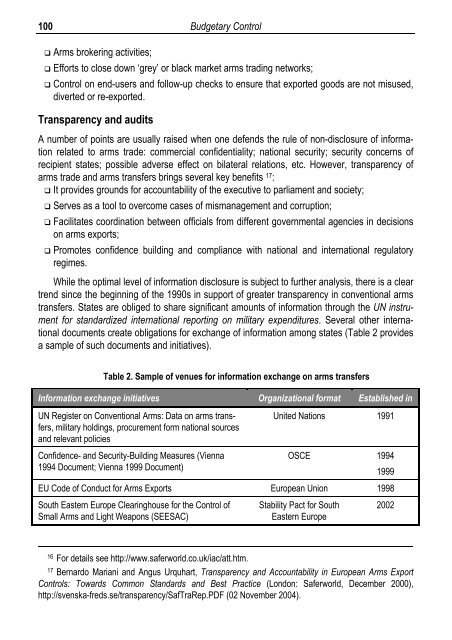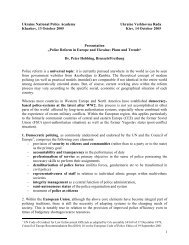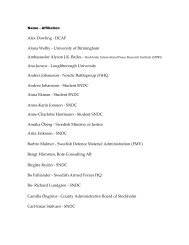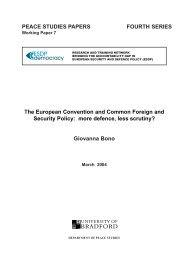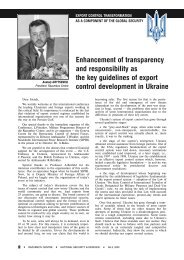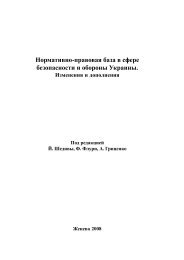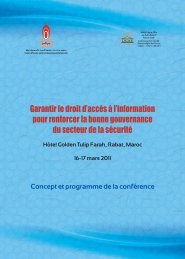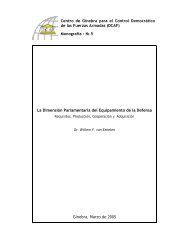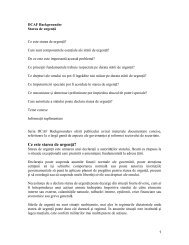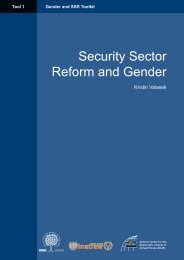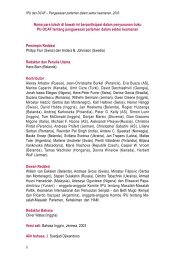Civil-Military Relations and Democratic Control of the Security Sector
Civil-Military Relations and Democratic Control of the Security Sector
Civil-Military Relations and Democratic Control of the Security Sector
Create successful ePaper yourself
Turn your PDF publications into a flip-book with our unique Google optimized e-Paper software.
100<br />
Arms brokering activities;<br />
Budgetary <strong>Control</strong><br />
Efforts to close down ‘grey’ or black market arms trading networks;<br />
<strong>Control</strong> on end-users <strong>and</strong> follow-up checks to ensure that exported goods are not misused,<br />
diverted or re-exported.<br />
Transparency <strong>and</strong> audits<br />
A number <strong>of</strong> points are usually raised when one defends <strong>the</strong> rule <strong>of</strong> non-disclosure <strong>of</strong> information<br />
related to arms trade: commercial confidentiality; national security; security concerns <strong>of</strong><br />
recipient states; possible adverse effect on bilateral relations, etc. However, transparency <strong>of</strong><br />
arms trade <strong>and</strong> arms transfers brings several key benefits 17 :<br />
It provides grounds for accountability <strong>of</strong> <strong>the</strong> executive to parliament <strong>and</strong> society;<br />
Serves as a tool to overcome cases <strong>of</strong> mismanagement <strong>and</strong> corruption;<br />
Facilitates coordination between <strong>of</strong>ficials from different governmental agencies in decisions<br />
on arms exports;<br />
Promotes confidence building <strong>and</strong> compliance with national <strong>and</strong> international regulatory<br />
regimes.<br />
While <strong>the</strong> optimal level <strong>of</strong> information disclosure is subject to fur<strong>the</strong>r analysis, <strong>the</strong>re is a clear<br />
trend since <strong>the</strong> beginning <strong>of</strong> <strong>the</strong> 1990s in support <strong>of</strong> greater transparency in conventional arms<br />
transfers. States are obliged to share significant amounts <strong>of</strong> information through <strong>the</strong> UN instrument<br />
for st<strong>and</strong>ardized international reporting on military expenditures. Several o<strong>the</strong>r international<br />
documents create obligations for exchange <strong>of</strong> information among states (Table 2 provides<br />
a sample <strong>of</strong> such documents <strong>and</strong> initiatives).<br />
Table 2. Sample <strong>of</strong> venues for information exchange on arms transfers<br />
Information exchange initiatives Organizational format Established in<br />
UN Register on Conventional Arms: Data on arms transfers,<br />
military holdings, procurement form national sources<br />
<strong>and</strong> relevant policies<br />
United Nations 1991<br />
Confidence- <strong>and</strong> <strong>Security</strong>-Building Measures (Vienna<br />
OSCE 1994<br />
1994 Document; Vienna 1999 Document)<br />
1999<br />
EU Code <strong>of</strong> Conduct for Arms Exports European Union 1998<br />
South Eastern Europe Clearinghouse for <strong>the</strong> <strong>Control</strong> <strong>of</strong> Stability Pact for South<br />
2002<br />
Small Arms <strong>and</strong> Light Weapons (SEESAC)<br />
Eastern Europe<br />
16 For details see http://www.saferworld.co.uk/iac/att.htm.<br />
17 Bernardo Mariani <strong>and</strong> Angus Urquhart, Transparency <strong>and</strong> Accountability in European Arms Export<br />
<strong>Control</strong>s: Towards Common St<strong>and</strong>ards <strong>and</strong> Best Practice (London: Saferworld, December 2000),<br />
http://svenska-freds.se/transparency/SafTraRep.PDF (02 November 2004).


